| Revision as of 17:03, 27 February 2021 editP Aculeius (talk | contribs)Autopatrolled, Extended confirmed users, Pending changes reviewers20,340 edits Undid revision 1009249996 by Kaizen314 (talk) Not an error; these clauses must be separated by commas, as the thought begun at the start of the sentence is not yet complete.Tag: Undo← Previous edit | Revision as of 02:44, 28 February 2021 edit undoLibhye (talk | contribs)Extended confirmed users2,375 edits Classical Latin pronunciationTag: RevertedNext edit → | ||
| Line 17: | Line 17: | ||
| {{Roman government}} | {{Roman government}} | ||
| {{ancient Roman religion}} | {{ancient Roman religion}} | ||
| '''Romulus''' {{IPAc-en|ˈ|r|ɒ|m|j|ə|l|ə|s}} was the legendary ] and ] of ]. Various traditions attribute the establishment of many of Rome's oldest legal, political, religious, and social institutions to Romulus and his contemporaries. Although many of these traditions incorporate elements of ], and it is not clear to what extent a historical figure underlies the mythical Romulus, the events and institutions ascribed to him were central to the myths surrounding Rome's origins and cultural traditions. | '''Romulus''' ({{IPAc-en|ˈ|r|ɒ|m|j|ə|l|ə|s}}); {{IPA-lat|ˈroːmʊɫʊs|classical}}) was the legendary ] and ] of ]. Various traditions attribute the establishment of many of Rome's oldest legal, political, religious, and social institutions to Romulus and his contemporaries. Although many of these traditions incorporate elements of ], and it is not clear to what extent a historical figure underlies the mythical Romulus, the events and institutions ascribed to him were central to the myths surrounding Rome's origins and cultural traditions. | ||
| ==Traditional account== | ==Traditional account== | ||
Revision as of 02:44, 28 February 2021
Legendary founder and first king of Rome This article is about the founder and first king of Rome. For the mythical tale of Romulus Remus, see Romulus and Remus. For other uses, see Romulus (disambiguation).| Romulus | |
|---|---|
 Romulus and his twin brother Remus from a 15th-century frieze, Certosa di Pavia Romulus and his twin brother Remus from a 15th-century frieze, Certosa di Pavia | |
| 1st King of Rome | |
| In office 753–716 BC | |
| Succeeded by | Numa Pompilius |
| Personal details | |
| Born | Alba Longa |
| Died | Rome |
| Spouse | Hersilia |
| Parents |
|
| Politics of ancient Rome |
|---|
 |
| Periods |
|
| Constitution |
| Political institutions |
| Assemblies |
| Ordinary magistrates |
| Extraordinary magistrates |
| Public law |
| Senatus consultum ultimum |
| Titles and honours |
| Religion in ancient Rome |
|---|
 Marcus Aurelius (head covered) Marcus Aurelius (head covered)sacrificing at the Temple of Jupiter |
| Practices and beliefs |
| Priesthoods |
| Deities |
| Related topics |
Romulus (/ˈrɒmjələs/); Template:IPA-lat) was the legendary founder and first king of Rome. Various traditions attribute the establishment of many of Rome's oldest legal, political, religious, and social institutions to Romulus and his contemporaries. Although many of these traditions incorporate elements of folklore, and it is not clear to what extent a historical figure underlies the mythical Romulus, the events and institutions ascribed to him were central to the myths surrounding Rome's origins and cultural traditions.
Traditional account
The myths concerning Romulus involve several distinct episodes and figures: the miraculous birth and youth of Romulus and Remus, his twin brother; Remus' murder and the founding of Rome; the Rape of the Sabine Women; the war with the Sabines; Titus Tatius; the establishment of Roman institutions; and the death or apotheosis of Romulus, and succession of Numa Pompilius.
Romulus and Remus
Main article: Romulus and RemusRomulus and his twin brother Remus were the sons of Rhea Silvia (the daughter of Numitor, the former king of Alba Longa) and the god Mars. Through her, the twins are descended from the Trojan hero Aeneas and Latinus, the mythical founder of the kingdom of Latium.
Before the twins' birth, Numitor had been usurped by his brother, Amulius. After seizing the throne, Amulius murdered Numitor's son, and condemned Rhea to perpetual virginity by consecrating her a Vestal. Rhea, however, became pregnant, said to be by the god Mars. Amulius had her imprisoned and, upon the twins' birth, ordered that they be thrown to their death into the rain-swollen Tiber. Instead of carrying out the king's orders, his servants left the twins along the riverbank at the foot of Palatine Hill.
In the traditional account of the legend, a she-wolf happened upon the twins, who were at the foot of a fig tree. She suckled and tended them by a cave until they were found by the herdsman Faustulus and his wife, Acca Larentia. The brothers grew to manhood among the shepherds and hill-folk.
After becoming involved in a conflict between the followers of Amulius and those of their grandfather Numitor, they learned the truth of their origin. They overthrew and killed Amulius and restored Numitor to the throne. The princes set out to establish a city of their own.
They returned to the hills overlooking the Tiber, the site where they had been exposed as infants. They could not agree on which hill should house the new city. When an omen to resolve the controversy failed to provide a clear indication, the conflict escalated and Romulus or one of his followers killed Remus. In a variant of the legend, the augurs favoured Romulus, who proceeded to plough a square furrow around the Palatine Hill to demarcate the walls of the future city. When Remus derisively leapt over the "walls" to show how inadequate they were against invaders, Romulus struck him down in anger. In another variant, Remus died during a melée, along with Faustulus.
Establishment of the city
The founding of the city by Romulus was commemorated annually on April 21, with the festival of the Parilia. Romulus's first act was to fortify the Palatine, in the course of which he made a sacrifice to the gods. He laid out the city's boundaries with a furrow that he ploughed, performed another sacrifice, and with his followers set to work building the city itself. Romulus sought the assent of the people to become their king. With Numitor's help, he addressed them and received their approval. Romulus accepted the crown after he sacrificed and prayed to Jupiter, and after receiving favourable omens.
Romulus divided the populace into three tribes, known as the Ramnes, Titienses, and Luceres, for taxation and military purposes. Each tribe was presided over by an official known as a tribune, and was further divided into ten curia, or wards, each presided over by an official known as a curio. Romulus also allotted a portion of land to each ward, for the benefit of the people. Nothing is known of the manner in which the tribes and curiae were taxed, but for the military levy, each curia was responsible for providing one hundred foot soldiers, a unit known as a century, and ten cavalry. Each Romulean tribe thus provided about one thousand infantry, and one century of cavalry; the three hundred cavalry became known as the Celeres, "the swift", and formed the royal bodyguard.
Choosing one hundred men from the leading families, Romulus established the Roman senate. These men he called patres, the city fathers; their descendants came to be known as "patricians", forming one of the two major social classes at Rome. The other class, known as the "plebs" or "plebeians", consisted of the servants, freedmen, fugitives who sought asylum at Rome, those captured in war, and others who were granted Roman citizenship over time.
To encourage the growth of the city, Romulus outlawed infanticide, and established an asylum for fugitives on the Capitoline Hill. Here freemen and slaves alike could claim protection and seek Roman citizenship.
Rape of the Sabine Women
Main article: The Rape of the Sabine Women Further information: Battle of the Lacus CurtiusThe new city was filled with colonists, most of whom were young, unmarried men. While fugitives seeking asylum helped the population grow, single men greatly outnumbered women. With no intermarriage taking place between Rome and neighboring communities, the new city would eventually fail. Romulus sent envoys to neighboring towns, appealing to them to allow intermarriage with Roman citizens, but his overtures were rebuffed. Romulus formulated a plan to acquire women from other settlements. He announced a momentous festival and games, and invited the people of the neighboring cities to attend. Many did, in particular the Sabines, who came in droves. At a prearranged signal, the Romans began to snatch and carry off the marriageable women among their guests.
The aggrieved cities prepared for war with Rome, and might have defeated Romulus had they been fully united. But impatient with the preparations of the Sabines, the Latin towns of Caenina, Crustumerium, and Antemnae took action without their allies. Caenina was the first to attack; its army was swiftly put to flight, and the town taken. After personally defeating and slaying the prince of Caenina in single combat, Romulus stripped him of his armour, becoming the first to claim the spolia opima, and vowed a temple to Jupiter Feretrius. Antemnae and Crustumerium were conquered in turn. Some of their people, chiefly the families of the abducted women, were allowed to settle at Rome.
Following the defeat of the Latin towns, the Sabines, under the leadership of Titus Tatius, marshalled their forces and advanced upon Rome. They gained control of the citadel by bribing Tarpeia, the daughter of the Roman commander charged with its defense. Without the advantage of the citadel, the Romans were obliged to meet the Sabines on the battlefield. The Sabines advanced from the citadel, and fierce fighting ensued. The nearby Lacus Curtius is said to be named after Mettius Curtius, a Sabine warrior who plunged his horse into its muck to stymie his Roman pursuers as he retreated. At a critical juncture in the fighting, the Romans began to waver in the face of the Sabine advance. Romulus vowed a temple to Jupiter Stator, to keep his line from breaking. The bloodshed finally ended when the Sabine women interposed themselves between the two armies, pleading on the one hand with their fathers and brothers, and on the other with their husbands, to set aside their arms and come to terms. The leaders of each side met and made peace. They formed one community, to be jointly ruled by Romulus and Tatius.
Subsequent events
The two kings presided over a growing city for a number of years, before Tatius was slain in a riot at Lavinium, where he had gone to make a sacrifice. Shortly before, a group of envoys from Laurentum had complained of their treatment by Tatius' kinsmen, and he had decided the matter against the ambassadors. Romulus resisted calls to avenge the Sabine king's death, instead reaffirming the Roman alliance with Lavinium, and perhaps preventing his city from splintering along ethnic lines.
In the years following the death of Tatius, Romulus is said to have conquered the city of Fidenae, which, alarmed by the rising power of Rome, had begun raiding Roman territory. The Romans lured the Fidenates into an ambush, and routed their army; as they retreated into their city, the Romans followed before the gates could be shut, and captured the town. The Etruscan city of Veii, nine miles up the Tiber from Rome, also raided Roman territory, foreshadowing that city's role as the chief rival to Roman power over the next three centuries. Romulus defeated Veii's army, but found the city too well defended to besiege, and instead ravaged the countryside.
Death and succession
After a reign of thirty-seven years, Romulus is said to have disappeared in a whirlwind during a sudden and violent storm, as he was reviewing his troops on the Campus Martius. Livy says that Romulus was either murdered by the senators, torn limb from limb out of jealousy, or was raised to heaven by Mars, god of war. Livy believes the last theory regarding the legendary king's death, as it allows the Romans to believe that the gods are on their side, a reason for them to continue expansion under Romulus' name.
Romulus acquired a cult following, which later became assimilated with the cult of Quirinus, perhaps originally the indigenous god of the Sabine population. As the Sabines had not had a king of their own since the death of Titus Tatius, the next king, Numa Pompilius, was chosen from among the Sabines. Romulus was buried beneath the steps to the Curia Julia, or Senate House, in the Roman Forum.
Primary sources
Quintus Fabius Pictor is relied upon as a source for Livy, Dionysius, and Plutarch, while other significant sources include Ovid's Fasti, and Virgil's Aeneid. Greek historians had traditionally claimed that Rome was founded by Greeks. This account can be dated to the logographer Hellanicus of Lesbos of 5th-century BC, who named Aeneas as its founder. To Roman historians, however, Romulus is the founder of Rome and the first "Roman". They connect Romulus to Aeneas by blood and they mention a prior settlement on Palatine Hill, sometimes attributing it to Evander and his Greek colonists. To the Romans, Rome was the institutions and traditions they credit to their legendary founder.
Modern scholarship
The legend as a whole encapsulates Rome's ideas of itself, its origins and moral values. For modern scholarship, it remains one of the most complex and problematic of all foundation myths. Ancient historians had no doubt that Romulus gave his name to the city. Most modern historians believe his name is a back-formation from the name of the city. Roman historians dated the city's foundation to between 758 and 728 BC, and Plutarch reports the calculation of Varro's friend Tarutius that 771 BC was the birth year of Romulus and his twin. A tradition that gave Romulus a distant ancestor in the semi-divine Trojan prince Aeneas was further embellished, and Romulus was made the direct ancestor of Rome's first Imperial dynasty. It is unclear whether or not the tale of Romulus or that of the twins are original elements of the foundation myth, or whether both or either were added.
Romulus-Quirinus

Ennius (fl. 180s BC) refers to Romulus as a divinity in his own right, without reference to Quirinus. Roman mythographers identified the latter as an originally Sabine war-deity, and thus to be identified with Roman Mars. Lucilius lists Quirinus and Romulus as separate deities, and Varro accords them different temples. Images of Quirinus showed him as a bearded warrior wielding a spear as a god of war, the embodiment of Roman strength and a deified likeness of the city of Rome. He had a Flamen Maior called the Flamen Quirinalis, who oversaw his worship and rituals in the ordainment of Roman religion attributed to Romulus's royal successor, Numa Pompilius. There is however no evidence for the conflated Romulus-Quirinus before the 1st century BC.
Ovid in Metamorphoses XIV (lines 805-828) gives a description of the deification of Romulus and his wife Hersilia, who are given the new names of Quirinus and Hora respectively. Mars, the father of Romulus, is given permission by Jupiter to bring his son up to Olympus to live with the Olympians.
One theory of this tradition concerns the emergence of two mythical figures from a single, earlier legend. Romulus is a founding hero, Quirinus may have been a god of the harvest, and the Fornacalia was a festival celebrating a staple crop (spelt). Through the traditional dates from the tales and the festivals, they are each associated with one another. A legend of the murder of such a founding hero, the burying of the hero's body in the fields (found in some accounts), and a festival associated with that hero, a god of the harvest, and a food staple is a pattern recognized by anthropologists. Called a "dema archetype", this pattern suggests that in a prior tradition, the god and the hero were in fact the same figure and later evolved into two.
Historicity
Possible historical bases for the broad mythological narrative remain unclear and disputed.
Modern scholarship approaches the various known stories of the myth as cumulative elaborations and later interpretations of Roman foundation myth. Particular versions and collations were presented by Roman historians as authoritative, an official history trimmed of contradictions and untidy variants to justify contemporary developments, genealogies and actions in relation to Roman morality. Other narratives appear to represent popular or folkloric tradition; some of these remain inscrutable in purpose and meaning. T.P. Wiseman sums up the whole issue as the mythography of an unusually problematic foundation and early history.
The unsavoury elements of many of the myths concerning Romulus have led some scholars to describe them as "shameful" or "disreputable." In antiquity such stories became part of anti-Roman and anti-pagan propaganda. More recently, the historian Hermann Strasburger postulated that these were never part of authentic Roman tradition, but were invented and popularized by Rome's enemies, probably in Magna Graecia, during the latter part of the fourth century BC. This hypothesis is rejected by other scholars, such as Tim Cornell (1995), who notes that by this period, the story of Romulus and Remus had already assumed its standard form, and was widely accepted at Rome. Other elements of the Romulus mythos clearly resemble common elements of folk tale and legend, and thus strong evidence that the stories were both old and indigenous. Likewise, Momigliano finds Strasburger's argument well-developed, but entirely implausible; if the Romulus myths were an exercise in mockery, they were a signal failure.
On February 17, 2020, the Agenzia Nazionale Stampa Associata reported that a hypogeum containing a tufa sarcophagus had been discovered near the Lapis Niger in the Roman forum. The tomb was dated to the sixth century BC, and was found together with the apparent remains of an altar dedicated to Romulus, placed in the spot where Romulus was thought to have been buried.
Depictions in art
The episodes which make up the legend, most significantly that of the rape of the Sabine women, the tale of Tarpeia, and the death of Tatius have been a significant part of ancient Roman scholarship and the frequent subject of art, literature and philosophy since ancient times.
Palazzo Magnani
In the late 16th century, the wealthy Magnani family from Bologna commissioned a series of artworks based on the Roman foundation myth. The artists contributing works included a sculpture of Hercules with the infant twins by Gabriele Fiorini, featuring the patron's own face. The most important works were an elaborate series of frescoes collectively known as Histories of the Foundation of Rome by the Brothers Carracci: Ludovico, Annibale, and Agostino.
-
 Romulus marking the city's boundaries with a plough
Romulus marking the city's boundaries with a plough
-
 The Asylum (Inter duos Lucos)
The Asylum (Inter duos Lucos)
-
 The rape of the Sabine women
The rape of the Sabine women
-
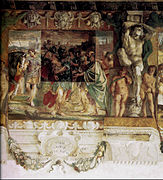 Romulus dedicating the temple to Jupiter Feretrius
Romulus dedicating the temple to Jupiter Feretrius
-
 The Battle of the Lacus Curtius
The Battle of the Lacus Curtius
-
 The death of Titus Tatius in Laurentium
The death of Titus Tatius in Laurentium
-
 Romulus appearing to Proculus Julius
Romulus appearing to Proculus Julius
-
 The Pride of Romulus
The Pride of Romulus
The rape of the Sabine women
-
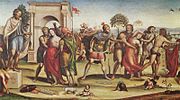 Ratto delle Sabine "The Rape of the Sabines", Il Sodoma (1507)
Ratto delle Sabine "The Rape of the Sabines", Il Sodoma (1507)
-
 L'Enlèvement des Sabines "The Abduction of the Sabines", Nicolas Poussin (1638)
L'Enlèvement des Sabines "The Abduction of the Sabines", Nicolas Poussin (1638)
-
 The Rape of the Sabine Women, Peter Paul Rubens (1634–36)
The Rape of the Sabine Women, Peter Paul Rubens (1634–36)
-
 Ratto delle Sabine "Rape of the Sabines", Giambologna (1583)
Ratto delle Sabine "Rape of the Sabines", Giambologna (1583)
-
Ratto delle Sabine "The Rape of the Sabines", Jacopo Ligozzi (c.1565-1627)
-
 L'Enlèvement des Sabines "The Abduction of the Sabines", Attributed to Theodoor van Thulden (17th c.)
L'Enlèvement des Sabines "The Abduction of the Sabines", Attributed to Theodoor van Thulden (17th c.)
-
 "The Rape of the Sabine Women", Sebastiano Ricci (c. 1700)
"The Rape of the Sabine Women", Sebastiano Ricci (c. 1700)
-
 Der Raub der Sabinerinnen "The Rape of the Sabine Women", Johann Heinrich Schönfeld (1640)
Der Raub der Sabinerinnen "The Rape of the Sabine Women", Johann Heinrich Schönfeld (1640)
-
 The Rape Of The Sabines – The Abduction, Charles Christian Nahl (1870)
The Rape Of The Sabines – The Abduction, Charles Christian Nahl (1870)
-
 The Rape Of The Sabines – The Captivity, Charles Christian Nahl (1871)
The Rape Of The Sabines – The Captivity, Charles Christian Nahl (1871)
-
 The Rape Of The Sabines – The Invasion, Charles Christian Nahl (1871)
The Rape Of The Sabines – The Invasion, Charles Christian Nahl (1871)
Tarpeia
-
 The Vestal Virgin Tarpeia Beaten by Tatius’ soldiers Il Sodoma (16th c.)
The Vestal Virgin Tarpeia Beaten by Tatius’ soldiers Il Sodoma (16th c.)
-
 Tarpeia's punishment, Pentelic marble fragment from the Frieze of the Basilica Aemilia (100 BC-100 AD
Tarpeia's punishment, Pentelic marble fragment from the Frieze of the Basilica Aemilia (100 BC-100 AD
-
 Reconstruction of Basilica Aemilia Frieze marble fragment
Reconstruction of Basilica Aemilia Frieze marble fragment
-
 Tarpeia, Illustration from Pictura loquens "the Heroic Accounts of Hadrian Schoonebeeck" (1695) (14751427905)
Tarpeia, Illustration from Pictura loquens "the Heroic Accounts of Hadrian Schoonebeeck" (1695) (14751427905)
-
 Tarpeia conspires with Tatius in an illustration from The story of the Romans by Hélène Adeline Guerber (1896)
Tarpeia conspires with Tatius in an illustration from The story of the Romans by Hélène Adeline Guerber (1896)
Hersilia
-
 Print from Romolo ed Ersilia, final scene, Act 3, Artist;: Giovanni Battista Cipriani, Engraver: Francesco Bartolozzi (1781)
Print from Romolo ed Ersilia, final scene, Act 3, Artist;: Giovanni Battista Cipriani, Engraver: Francesco Bartolozzi (1781)
-
 Hersilia from a detail of Les Sabines "The Intervention of the Sabine Women", Jacques-Louis David (1799)
Hersilia from a detail of Les Sabines "The Intervention of the Sabine Women", Jacques-Louis David (1799)
-
 Ersilia separa Romolo da Tazio "Hersilia Separating Romulus and Tatius, Guercino (1645)
Ersilia separa Romolo da Tazio "Hersilia Separating Romulus and Tatius, Guercino (1645)
Death of Tatius
The subject for the 1788 Prix de Rome was the death of Tatius (La mort de Tatius). Garnier won the contest.
-
Version by Étienne-Barthélémy Garnier, now in the École nationale supérieure des beaux-arts, Paris.
-
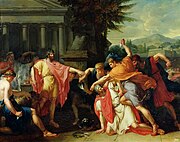 Version by Girodet, now in the Musée des Beaux-Arts d'Angers.
Version by Girodet, now in the Musée des Beaux-Arts d'Angers.
-
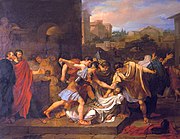 Version by Jacques Réattu, now in the Musée Réattu, Arles.
Version by Jacques Réattu, now in the Musée Réattu, Arles.
Death of Romulus
-
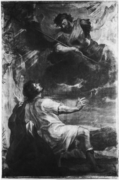 "Apparition of Romulus before Proculus", Rubens (17th c.)
"Apparition of Romulus before Proculus", Rubens (17th c.)
See also
Notes
- Dionysius describes an ambush of Numitor's son, who was hunting; Livy indicates that there were multiple sons, but does not give any details of their murder. Dionysius also gives an alternate name, Ilia, for Rhea Silvia.
- Dionysius suggests that the Parilia may have predated the founding of the city, and been chosen by Romulus because it was an auspicious occasion.
- The founding of Rome fell on the Parilia, according to the oldest surviving Roman calendar (Rodriguez Mayorga 2010, p. 97).
- These names probably do not date from the time of Romulus; modern scholars have inferred that they were originally ethnic tribes representing different elements of the early Roman population, with the Ramnes representing the Latins, the Titienses the Sabines, and the Luceres the Etruscans. The Luceres may have been a later addition to the original Romulean tribes, but as the Tiber formed the traditional boundary between Latium and Etruria, it is not unlikely that there were Etruscan settlers from the earliest period.
- As the name suggests, a unit of one hundred men, although in later times a century was usually smaller, comprising about sixty men.
- Jupiter the Steadfast.
- The archaeologist Andrea Carandini is one of very few modern scholars who accept Romulus and Remus as historical figures, based on the 1988 discovery of an ancient wall on the north slope of the Palatine Hill in Rome. Carandini dates the structure to the mid-8th century BC and names it the Murus Romuli.
See: Carandini (1997), La nascita di Roma. Dèi, lari, eroi e uomini all'alba di una civiltà (Torino: Einaudi); Carandini (2006), Remo e Romolo. Dai rioni dei Quiriti alla città dei Romani (775/750 - 700/675 a. C. circa) (Torino: Einaudi); and Carandini (2011). Rome: Day One. Princeton, NJ: Princeton University Press. ISBN 978-0-691-13922-7.
Citations
- ^ Livy, History of Rome i. 3.
- Dionysius of Halicarnassus, Roman Antiquities i. 76.
- Dionysius, i. 77–79.
- ^ Livy, i. 3–6.
- Dionysius, i. 79–83.
- Dionysius, i. 85–87.
- Livy, i. 7.
- Dionysius, i. 88.
- Dionysius, ii. 3–6.
- Dionysius, ii. 7.
- Varro Reatinus, On the Latin Language v. 81, 89.
- Livy, i. 13, 15.
- Dionysius, ii. 13.
- ^ Livy, i. 9.
- Dionysius, ii. 8, 12, 13.
- Livy, i. 8.
- Dionysius, ii. 15.
- Livy, i. 10.
- Livy, i. 11–13.
- Livy, i. 13.
- Livy, i. 14–15.
- Livy, i. 16.
- Livy, i. 17, 18.
- Metcalfe, Tom (February 21, 2020). "Tomb of Rome's mythical founder Romulus unearthed". Live Science. Retrieved 2020-02-22.
- Rodriguez Mayorgas (2010), pp. 92–94
- Plutarch. Life of Romulus. 12.5.
- Evans, 103 and footnote 66: citing quotation of Ennius in Cicero, 1.41.64.
- Fishwick, Duncan (1993), The Imperial Cult in the Latin West (2nd ed.), Leiden: Brill, p. 53, ISBN 978-90-04-07179-7.
- Cook, John Granger (2018). Empty Tomb, Resurrection, Apotheosis. p. 263. doi:10.1628/978-3-16-156584-7. ISBN 9783161565847.
- Brelich, Angelo. 1960. Quirinus: una divinita' romana alla luce della comparazione storica "Studi e Materiali di Storia delle religioni".
- Wiseman, T. P. (1995), Remus, A Roman Myth, Cambridge: Cambridge University Press.
- ^ Momigliano, Arnoldo (2007), "An interim report on the origins of Rome", Terzo contributo alla storia degli studi classici e del mondo antico, vol. 1, Rome, IT: Edizioni di storia e letteratura, pp. 545–98, ISBN 9788884983633. — A critical, chronological review of historiography related to Rome's origins.
- ^ Cornell, Tim (1995), The Beginnings of Rome: Italy and Rome from the Bronze Age to the Punic Wars (c. 1000–264 BC). London: Routledge, ISBN 978-1-136-75495-1.
- Newsroom (2020), "Hypogeum with sarcophagus found in Forum." ANSA. 17 February.
- Associated Press (2020), "Sarcophagus dedicated to Romulus discovered in Roman forum." Phys.org. February 18.
Bibliography
- Cornell, T. (1995), The Beginnings of Rome: Italy and Rome from the Bronze Age to the Punic Wars (c. 1000–264 BC), Routledge, ISBN 978-1-136-75495-1
- Rodríguez Mayorgas, Ana (2010), "Romulus, Aeneas and the Cultural Memory of the Roman Republic" (PDF), Athenaeum, 98 (1): 89–109, retrieved 14 December 2016
- Tennant, P. M. W. (1988). "The Lupercalia and the Romulus and Remus Legend" (PDF). Acta Classica. XXXI: 81–93. ISSN 0065-1141. Retrieved 19 November 2016.
- Wiseman, T. P. (1983). "The Wife and Children of Romulus". The Classical Quarterly. XXXI (ii). Cambridge University Press: 445–452. doi:10.1017/S0009838800034704. JSTOR 638787.
- Cook, John Granger (2018), Empty Tomb, Apotheosis, Resurrection, p. 263.
Ancient Sources
- Dionysius of Halicarnassus, Roman Antiquities i & ii.
- Livy, History of Rome i–v.
Additional reading
- Carandini, Andrea (2011). Rome: Day One. Princeton, N.J: Princeton University Press. ISBN 978-0-691-13922-7.
- Forsythe, Gary (2005). A Critical History of Early Rome: From Prehistory to the First Punic War. Berkeley: University of California Press. ISBN 978-0-520-22651-7.
| Legendary titles | ||
|---|---|---|
| New creation | King of Rome 753–717 |
Succeeded byNuma Pompilius |
| Preceded byNumitor | King of Alba Longa | |
| Kings of Rome | |
|---|---|
|
| Works of Plutarch | |
|---|---|
| Works | |
| Lives |
|
| Translators and editors | |
| |
| Ancient Roman religion and mythology | ||
|---|---|---|
| Deities (Dii Consentes) |  | |
| Legendary figures | ||
| Legendary beings | ||
| Texts | ||
| Concepts and practices | ||
| Philosophy | ||
| Events | ||
| Objects | ||
| Variations | ||
| See also | ||